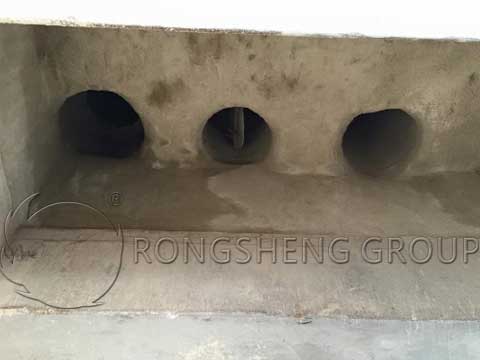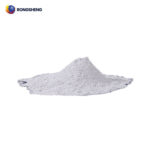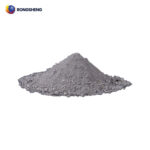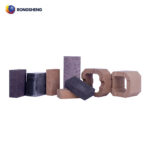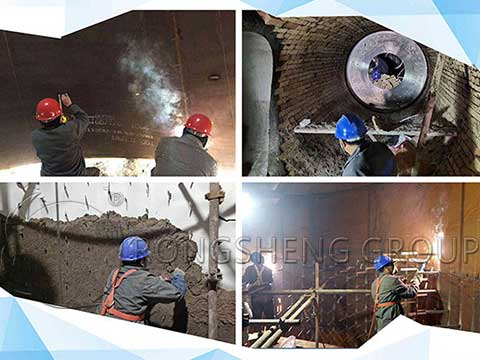Selection of Corundum Brick Refractory Materials for Waste Melting Furnace
As a part of the garbage incineration system, the garbage melting furnace treats the solid pollutants generated after garbage incineration. The high-temperature melting process is used to solidify and decompose heavy metals, dioxins and other substances in solid pollutants. The selection of refractory materials for garbage melting furnace should be comprehensively considered in combination with melting furnace operating conditions and slag properties. Among them, the slag resistance of the material should be considered as a key consideration. Under the conditions of the melting furnace operating temperature above 1300℃, the operating atmosphere is an oxidizing atmosphere, and the SiO2 content in the slag is high, static crucible slag resistance test and microstructure analysis are used. After comparing the slag resistance of high-purity corundum bricks, chrome corundum bricks and AZS bricks, it is found that chrome corundum bricks and fused cast AZS bricks have ideal slag resistance.

Corundum Brick Refractory Materials for Waste Melting Furnace
At present, the commonly used refractories for garbage melting furnaces need to choose suitable refractories according to the atmosphere in the furnace and the chemical composition of the slag.
According to the furnace atmosphere, SiC materials and C-SiC materials are often used in reducing atmosphere. Al2O3-Cr2O3 materials and MgO-Cr2O3 materials are often used for oxidizing atmosphere.
According to the chemical composition of the slag, the ratio of w(CaO)/w(SiO2) is used as a reference standard. When the ratio is greater than 1, the slag is alkaline and MgO-Cr2O3 materials are often used. When the ratio is close to or less than 1, the slag is acidic, and Al2O3-Cr2O3 materials are often used.
Based on the above information, the following issues need to be considered when discussing the selection of refractory materials for waste melting furnaces:
- (1) The constraints of the melting furnace operating conditions on the suitability of materials;
- (2) The chemical composition of the solid pollutants processed by the melting furnace requires the slag resistance of the material.
Among them, the problem (1) embodies the rigid requirements for materials in the working environment presented by the melting furnace. Including material use temperature, high temperature strength, thermal shock stability and applicable atmosphere, etc. These requirements can be used for reference or screening through existing scientific research results. Question (2) reflects more differences and uncertainties. Different garbage melting furnaces may have different choices of refractory materials even if their working conditions are the same or similar, but the solid pollutants handled are different. Therefore, when selecting refractories for garbage melting furnaces, the slag resistance of refractories should be one of the key test items.
The working temperature of garbage melting furnace is usually ≥1300℃. The electric heating process is adopted, the atmosphere in the furnace is an oxidizing atmosphere, and the feeding and discharging method is continuous discharging. It can be obtained from the chemical composition of the slag that the ratio of w(CaO)/w(SiO2) is small, and the slag is acidic.
According to the working conditions of the melting furnace, SiC refractory materials can be excluded, and materials that can be used in an oxidizing atmosphere need to be selected. However, due to the strong acidity of the slag and the high content of SiO2, the MgO-Cr2O3 material will be greatly corroded by the slag in this environment, so it should be excluded. On this basis, in view of the conditions where the slag is more acidic and the content of SiO2 is greater, consider selecting materials that are more excellent in resisting the corrosion of molten glass as the selection materials. They are: high-purity corundum bricks, chrome corundum bricks, and fused cast AZS bricks. The main chemical composition of the selected refractory material needs to meet the following conditions.
- (1) w (Al2O3) ≥99.2% in high-purity corundum bricks.
- (2) In the chrome corundum brick, w (Al2O3+Cr2O3) ≥ 99.0%, w (Cr2O3) ≥ 50.0%.
- (3) w (ZrO2) ≥ 33.0% in fused cast AZS bricks.
Rongsheng Corundum Brick Refractory Manufacturer
Rongsheng is an experienced refractory material manufacturer. Rongsheng’s refractory products have been sold to more than 60 countries and regions all over the world, for example, Thailand, UAE, Turkey, Kuwait, South Africa, Malaysia, Vietnam, Netherlands, Philippines, Singapore, Egypt, Russia, etc. Rongsheng provides refractory linings for garbage melting furnaces, not only chrome corundum bricks and fused cast AZS bricks, Fused Cast Corundum Brick, but also various high-performance wear-resistant refractory castables. For more information and a free quote, please contact us and we will provide you with services according to your specific needs.

